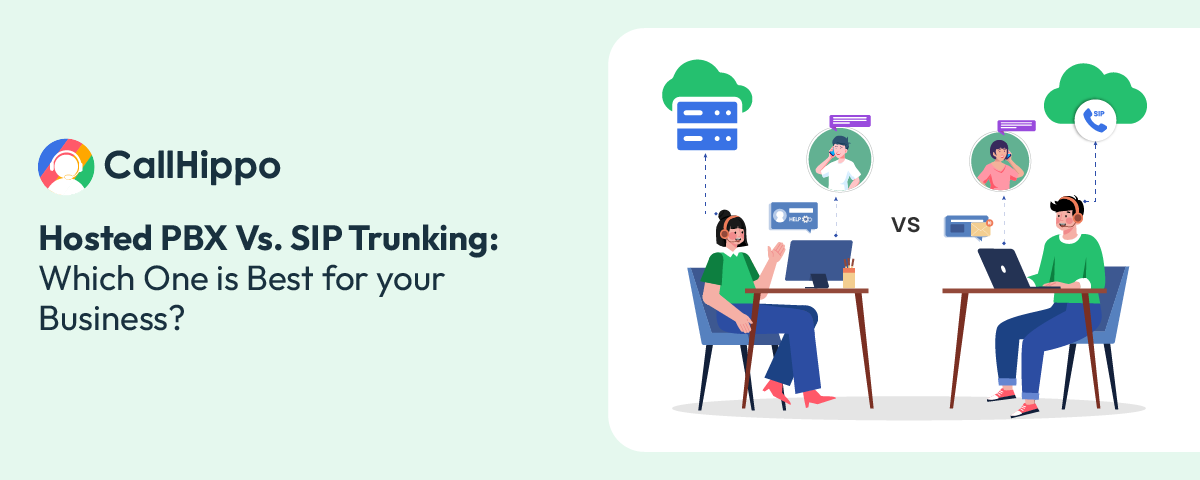As technology advances, traditional phone systems are giving way to more flexible, scalable, and cost-effective solutions. Two such innovations in the realm of telephony are Hosted Private Branch Exchange (PBX) and Session Initiation Protocol (SIP) Trunking. In fact, the Hosted PBX market size is expected to grow at a CAGR of 12% from 2021 to 2027. Let’s delve into what these technologies entail and how they revolutionize the way businesses manage their communications.
What Is Hosted PBX?

Hosted PBX, also known as cloud PBX or virtual PBX, is a telephony system that operates via the Internet. Unlike traditional PBX systems that require physical hardware and extensive on-site setup, hosted PBX operates virtually through a service provider’s servers.
Hosted PBX relies on cloud-based technology, enabling businesses to access a full suite of telephony features without the need for on-premises hardware. Service providers manage and maintain the infrastructure, reducing the burden on in-house IT teams.
What Is SIP Trunking?

SIP Trunking is a technology that enables the transmission of voice and other unified communications over the Internet using the SIP protocol. It replaces traditional phone lines by allowing businesses to connect their PBX system to the Public Switched Telephone Network (PSTN) via the Internet.
IP PBX SIP Trunking offers unparalleled flexibility as it allows businesses to consolidate voice, data, and video communications over a single IP network. It enables scalability by allowing companies to add or remove channels according to demand.
"Ensure to weight the pros and cons of both while choosing hosted PBX vs. SIP trunking. Prioritize reliable internet connectivity and robust security measures regardless of the chosen solution. Consider consulting with telecommunications specialists to tailor the decision based on your specific communication requirements and long-term business goals."
Hosted PBX vs SIP trunking: Key Differences

Understanding the differences between these technologies is crucial for companies seeking to optimize their telephony infrastructure. Let’s delve into the key dissimilarities between SIP vs. PBX:
Hosted PBX
1. Infrastructure
- Hosted PBX operates using a cloud-based infrastructure provided by a third-party service provider. It doesn’t require on-premises hardware, as all the necessary equipment is hosted and managed off-site.
- It’s essentially a virtual phone system accessible via the internet, allowing businesses to utilize various telephony features without investing in physical PBX hardware.
2. Features and Functionality
- Hosted PBX systems offer a suite of features such as voicemail, auto-attendants, call forwarding, conference calling, and more.
- The functionality is often customizable, allowing businesses to tailor the system to their specific needs.
3. Scalability and Flexibility
- Hosted PBX solutions are highly scalable, enabling businesses to easily scale their phone systems up or down without the need for additional hardware investments.
- They provide flexibility in adapting to changing business requirements, making them ideal for growing enterprises.
4. Cost Structure
- The cost of Hosted PBX is typically subscription-based, where businesses pay for the services they use. This model reduces upfront costs and is often more cost-effective than traditional PBX systems.
You May Also Read : 7 Best USA SIP Trunk Providers
SIP Trunking
1. Connectivity and Protocol
- SIP trunking involves the use of Session Initiation Protocol (SIP) to establish and manage communication sessions over the Internet.
- It replaces traditional phone lines by enabling businesses to connect their Private Branch Exchange (PBX) systems to the Public Switched Telephone Network (PSTN) via the Internet.
2. Flexibility and Cost Savings

- SIP trunking PBX offers flexibility by consolidating voice, data, and video communications over a single IP network. It allows companies to add or remove channels according to demand, providing scalability.
- Businesses leveraging SIP trunking experience cost savings by eliminating separate networks for voice and data, reducing long-distance call charges, and optimizing resources.
3. Disaster Recovery and Resilience
- SIP trunking enhances disaster recovery capabilities by enabling calls to be rerouted easily to alternative locations or mobile devices in case of emergencies or network disruptions.
- It contributes to business continuity efforts by ensuring uninterrupted communication during unforeseen events.
4. Global Reach
- SIP trunking facilitates global connectivity, enabling businesses to establish a global presence by obtaining local phone numbers in different regions, thereby enhancing accessibility to customers worldwide.
Hosted PBX vs SIP Trunking: Pros & Cons
Hosted PBX
Pros
- It offers high scalability without requiring additional physical hardware, allowing businesses to easily add or remove lines or features as needed.
- Hosted PBX systems generally operate on a subscription-based model, eliminating the need for substantial upfront investments in hardware. This can result in cost savings compared to traditional PBX systems.
- Businesses can access a wide range of features like voicemail, call forwarding, auto-attendants, and conference calling. These features can be customized to suit specific business needs.
- Service providers manage system maintenance and updates, reducing the burden on in-house IT teams. This ensures that the system remains up-to-date and secure.
Cons
- Since Hosted PBX operates via the Internet, disruptions in Internet connectivity can affect call quality or accessibility.
- As the infrastructure is managed by the service provider, businesses might have limited control over certain aspects of the system, such as updates or customizations.
- Transmitting sensitive information over the internet raises potential security risks. While service providers implement security measures, businesses need to ensure data protection on their end.
You May Also Read : Top 10 Free PBX Open Source Software
SIP Trunking
Pros
- SIP Trunking eliminates the need for separate voice and data networks, reducing costs associated with long-distance calls and line rentals. It optimizes resources, leading to significant cost savings.
- Businesses can easily scale their communication channels up or down according to demand. It offers flexibility by consolidating various communication types over a single IP network.
- SIP Trunking enables businesses to establish a global presence by acquiring local phone numbers in different regions, facilitating better connectivity and accessibility to customers worldwide.
- SIP Trunking enhances disaster recovery capabilities, allowing calls to be redirected easily in case of emergencies or network failures, ensuring uninterrupted communication.
Cons
- Implementing SIP Trunking might require initial setup complexities, especially for businesses transitioning from traditional phone systems. Proper configuration is essential for optimal performance.
- Similar to Hosted PBX, SIP Trunking’s performance is heavily reliant on the quality and reliability of the internet connection. Poor internet connectivity can lead to call quality issues.
- Transmitting data over the internet poses security risks. Employing robust security measures, such as encryption and firewalls, is crucial to mitigate potential threats.
Hosted PBX vs SIP Trunking: What is Best For You?
Determining whether Hosted PBX or SIP Trunking is best for your business requires careful consideration of various factors to align with your specific communication needs, infrastructure, and future scalability. Let’s delve into how you can decide which solution suits your organization best:
1. Infrastructure and Scalability
Hosted PBX, utilizing cloud-based infrastructure, suits small to medium-sized businesses seeking a hassle-free telephony solution with scalable features without requiring significant hardware investments. SIP Trunking, ideal for established businesses with existing PBX systems, offers cost savings by leveraging IP-based communication and scalability without substantial hardware changes, optimizing existing infrastructure.
2. Features and Budget

Hosted PBX caters to businesses relying heavily on advanced telephony features, offering customizable options while adopting a subscription-based model for predictable monthly expenses. SIP Trunking benefits cost-conscious organizations by eliminating separate voice and data networks, reducing long-distance call expenses and providing global connectivity via local phone numbers in various regions.
3. Reliability and Security
Hosted PBX’s reliance on internet connectivity makes consistent and reliable internet crucial, with any disruptions potentially affecting call quality. Meanwhile, SIP Trunking’s performance also depends on internet reliability, demanding proper configuration to overcome initial setup complexities and robust security measures to mitigate potential risks associated with transmitting data over the internet.
Ultimately, the best choice between Hosted PBX and SIP Trunking depends on your business’s unique requirements, goals, existing infrastructure, and future growth plans. Consulting with telephony experts or service providers can further guide you in making an informed decision aligned with your communication needs.
You May Also Read : Virtual PBX Phone System: Definition & Benefits
Final Thoughts
The choice between Hosted PBX and SIP Trunking hinges on a business’s unique needs, infrastructure, and future objectives. Hosted PBX offers scalability, feature-rich options, and a subscription-based model suitable for smaller enterprises or those prioritizing customizable telephony features. Consulting with experts can further refine the choice, ensuring an optimal telephony solution that supports business growth and operational efficiency.
FAQs
1. What is a SIP Channel?
A SIP (Session Initiation Protocol) channel represents a pathway for communication using SIP. It’s essentially a single line that enables the transmission of voice, video, or data over an IP network.
2. Are SIP and PBX the same?
No, SIP (Session Initiation Protocol) and PBX (Private Branch Exchange) are not the same. SIP is a protocol used for initiating and terminating communication sessions over the Internet, while PBX refers to a telephony system that manages internal calls within an organization.
3. Is PBX better than VoIP?
PBX and VoIP (Voice over Internet Protocol) aren’t directly comparable, as PBX can operate using VoIP technology. VoIP refers to the method of transmitting voice calls over the internet, while PBX can be traditional (using physical hardware) or hosted (cloud-based), and it can utilize VoIP or traditional phone lines.
4. What’s the difference between SIP trunking, Hosted PBX and VoIP?
SIP trunking is the method of transmitting voice and data using SIP over the internet, typically connecting a PBX system to the PSTN. Hosted PBX is a cloud-based phone system offering various features without on-premises hardware, while VoIP is a technology transmitting voice calls over the internet.
5. How much bandwidth does a company need for hosted PBX?
Bandwidth requirements for hosted PBX depend on factors such as the number of users, concurrent calls, and usage of additional features like video conferencing. Generally, a good starting point is to allocate around 100 kbps (kilobits per second) per concurrent call for voice communication. However, bandwidth needs can vary based on the specific requirements and usage patterns of each company.

Subscribe to our newsletter & never miss our latest news and promotions.









